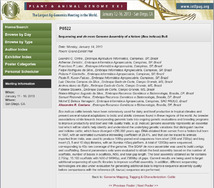Sequencing and de novo genome assembly of a nelore (Bos indicus) bull.
Sequencing and de novo genome assembly of a nelore (Bos indicus) bull.
Author(s): CINTRA, L. C.; ZERLOTINI, A.; LOBO, F. P.; SILVA, F. R. da; GIACHETTO, P. F.; KUSER-FALCÃO, P. R.; SILVA, L. O. C. da; EGITO, A. A. do; SIQUEIRA, F.; SILVA, N. M. A. da; PAIVA, S. R.; YAMAGISHI, M. E. B.; CAETANO, A. R.
Summary: Bos indicus cattle breeds have been extensively used for dairy and beef production in tropical climates and present several natural adaptations to biotic and abiotic stresses found in these regions of the world. As breeder associations stride towards incorporating genomic tools into ongoing genetic evaluations and breeding programs to improve productivity and beef and milk quality traits, a (B. indicus) genome assembly represents an essential tool which will be vital to help identify and understand the underlying genetic variations that distinguish taurine and indicine cattle, which have diverged >250,000 years ago. DNA obtained from semen from a Nelore bull born in 1987, with an estimated cumulative inbreeding coefficient of 29.4%, and that can be traced to animals imported from India, was used to produce 100bp paired-end sequences from short (300 and 700bp) and long insert (3, 5 and 10 kbp) libraries, with an Illumina HiSeq platform. A total of 120Gbp were sequenced, corresponding to 45x raw coverage of the genome. The SOAP de novo assembler was used to build contigs and scaffolding. Several parameters sets were evaluated to obtain the best assembly based on the number of scaffolds, number of bases in scaffolds, N50, and total gap length. The best assembly obtained so far contains 2.7Gbp, 15,103 scaffolds with N50 of 649Kbp, and 756Mbp of gaps. Current results are being used to target additional sequencing of specific libraries to improve scaffold assembly. In addition, different sequencing technologies are also under evaluation for generating additional data to improve sequence assembly quality before comparisons with the reference (B. taurus) sequence are performed.
Publication year: 2013
Types of publication: Abstract in annals or event proceedings
Observation
Some of Embrapa's publications are published as ePub files. To read them, use or download one of the following free software options to your computer or mobile device. Android: Google Play Books; IOS: iBooks; Windows and Linux: Calibre.
Access other publications
Access the Agricultural Research Database (BDPA) to consult Embrapa's full library collection and records.
Visit Embrapa Bookstore to purchase books and other publications sold by Embrapa.

